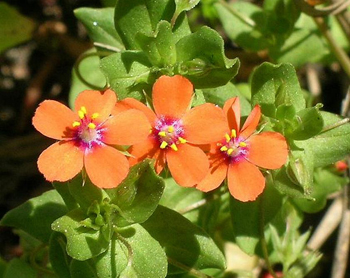Contents:
Common Names | Parts Usually Used | Plant(s) & Culture | Where Found | Medicinal Properties
Uses | Formulas or Dosages | Bibliography
Scientific Names

- Anagallis arvensis L.
- Primrose family
Common Names
- Poor man’s weatherglass
- Red chickweed
- Scarlet pimpernel
Parts Usually Used
The entire herb
Back to Top
Description of Plant(s) and Culture
Red pimpernel is a low annual plant; the square, procumbent or ascending stems reach a length of about 12 inches. The sessile, ovate leaves grow in opposite pairs or in threes, are blue-green on top, and have brown or black spots underneath. Starlike, axillary, red (or sometimes white or blue) flowers bloom from June to October. Their characteristic of closing when bad weather impends accounts for the plant’s “weatherglass” name.
Back to Top
Where Found
Grows particularly in cultivated and loamy soils all over North America, especially in coastal states, as well as in Europe and Asia.
Back to Top
Medicinal Properties
Cholagogue, diaphoretic, diuretic, expectorant, nervine, purgative, stimulant
Back to Top
Uses
In moderate doses, caused sweating and increased kidney activity. In large doses, it acts on the central nervous system and the brain, producing trembling along with watery stools and copious urine. In skilled hands, it can be useful for various nervous conditions, liver problems, and dyspepsia. A tincture of the plant is sometimes used for skin problems and external sores.
Back to Top
Warning
Improper doses can cause disagreeable internal effects. The fresh leaves can cause dermatitis. Do not use without medical supervision.
Back to Top
Bibliography
![]() The Herb Book
The Herb Book, by John Lust, Bantam Books, 666 Fifth Avenue, New York, NY. copyright 1974.
![]() Webster’s New World Dictionary
Webster’s New World Dictionary, Third College Edition, Victoria Neufeldt, Editor in Chief, New World Dictionaries: A Division of Simon & Schuster, Inc., 15 Columbus Circle, New York, NY 10023
